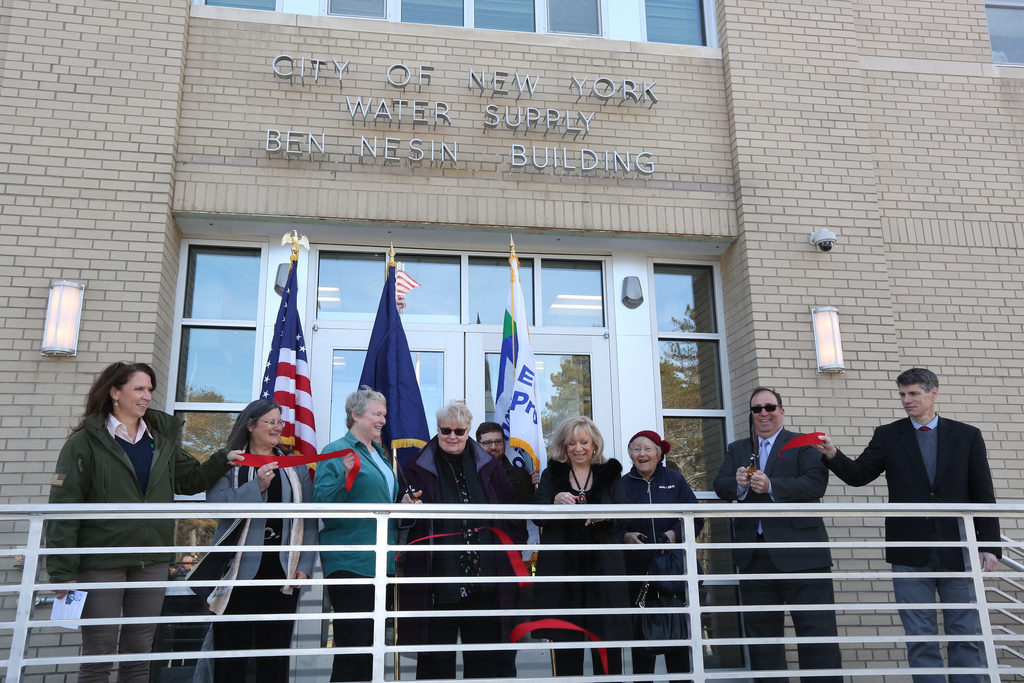DEP Celebrates the Finished Renovation of Ben Nesin Building at Ashokan Reservoir
March 25, 2019
City completes $10 million project to rehabilitate office building in Ulster County
Ben Nesin descendants join DEP, local officials for rededication ceremony
The New York City Department of Environmental Protection (DEP) was joined today by government leaders in Ulster County to celebrate the completion of a $10 million upgrade to the central office building at Ashokan Reservoir. The building on Route 28A was also rededicated in memory of Benjamin C. Nesin, a noted scientist and former director of laboratories for the New York City water supply. Several members of the Nesin family joined DEP for the ceremony.
The Ben Nesin Building will house about 35 employees who are responsible for the operation and maintenance of Ashokan Reservoir, Schoharie Reservoir and the watershed lands that surround them. DEP employees who specialize in dam safety and capital construction projects will also work in the building. Including those who work in the Ben Nesin Building, DEP employs about 80 people at the campus alongside Ashokan Reservoir.
“The newly refurbished Ben Nesin Building provides our employees with a modern space from which to operate, maintain and protect the Catskill Water Supply System,” DEP Commissioner Vincent Sapienza said. “I want to thank the employees who oversaw the renovations, the contractors who carried out the work, and the family of Ben Nesin for joining us on this special occasion. We are proud to rededicate the building today in memory of Mr. Nesin, who was a passionate and well-respected leader in the field of water quality science.”
The four-story building was constructed in 1961 to serve as a water quality laboratory and office. It stopped being used as a laboratory when DEP finished its new Kingston Laboratory in 2008, but the building continued to house engineers, watershed maintenance staff and other DEP employees. The renovation project began late in 2016. Workers replaced all windows, interior and exterior doors, and installed new systems for heating and air conditioning. The front entrance along Route 28A was reconfigured to allow for a safer crosswalk from the parking lot across the street, and a larger landing that complies with the Americans with Disabilities Act. Asbestos building materials and lead paint were also removed from the building. Plumbing and electric utilities throughout the building were also upgraded.
The project will seek silver-level LEED certification because it incorporated a number of environmentally responsible design elements. These included energy efficient lighting and HVAC equipment, additional insulation, water efficient fixtures, and the use of recycled and regionally sourced materials.
On Monday the building was rededicated in memory of Nesin, who served as the director of New York City’s water quality laboratories from 1945 until his death in 1964. The building was originally known as the Catskill Laboratory before it was dedicated as the Ben Nesin Laboratory on May 20, 1964. Nesin began working for the New York City Department of Water Supply, Gas & Electricity (a predecessor to DEP) as a chemist in 1927. He was the chemist in charge of the Mt. Prospect Laboratory in Brooklyn from 1931-1945, and was then appointed to oversee all five of the City’s water quality laboratories. His obituary noted that Nesin was “responsible for all problems of water supply toxicology and in general all matters related to the safety and general quality of the New York City water supply system.” He established systems to control pollution in the watershed, and oversaw investigations related to metals, herbicides and other potential pollutants. In the 1960s, Nesin was sent to Israel to help that country with various water supply challenges, including the potential development of the Jordan River as a source of drinking water.
DEP manages New York City’s water supply, providing more than 1 billion gallons of high-quality water each day to more than 9.6 million New Yorkers. This includes more than 70 upstate communities and institutions in Ulster, Orange, Putnam and Westchester counties who consume an average of 110 million total gallons of drinking water daily from New York City’s water supply system. This water comes from the Catskill, Delaware, and Croton watersheds that extend more than 125 miles from the City, and the system comprises 19 reservoirs, three controlled lakes, and numerous tunnels and aqueducts. DEP has nearly 6,000 employees, including almost 1,000 scientists, engineers, surveyors, watershed maintainers and other professionals in the watershed. In addition to its $70 million payroll and $168.9 million in annual taxes paid in upstate counties, DEP has invested more than $1.7 billion in watershed protection programs—including partnership organizations such as the Catskill Watershed Corporation and the Watershed Agricultural Council—that support sustainable farming practices, environmentally sensitive economic development, and local economic opportunity. In addition, DEP has a robust capital program with $19.7 billion in investments planned over the next decade that will create up to 3,000 construction-related jobs per year. For more information, visit nyc.gov/dep, like us on Facebook, or follow us on Twitter.





